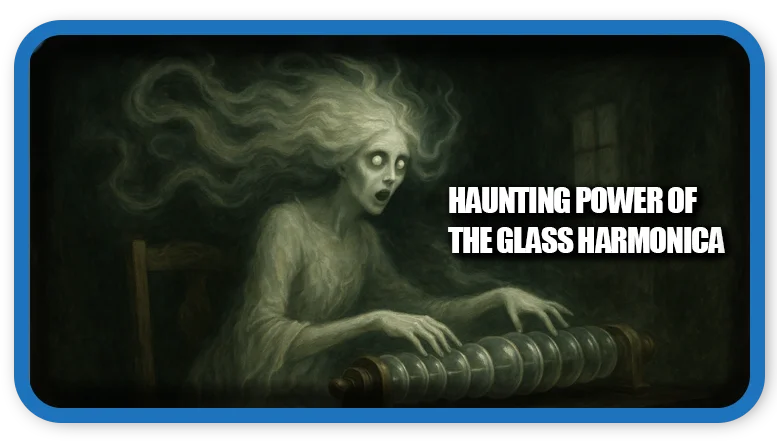⏲️ Estimated reading time: 4 min
Invented by Benjamin Franklin, the glass harmonica produced ghostly sounds that mesmerized audiences and frightened doctors. Its real effects were so intense that some places banned it. Discover the eerie story behind this rare instrument.
The glass harmonica, or armonica, is one of the most hauntingly beautiful and mysterious musical instruments ever created. Benjamin Franklin designed it in 1761, and it fascinated composers like Mozart and Beethoven. Yet, people also blamed it for emotional breakdowns, hallucinations, and even madness. In this post, we explore the eerie history of the glass harmonica, the psychological and medical effects it allegedly caused, and why some European cities banned it.
What Is the Glass Harmonica?
Unlike traditional instruments, the glass harmonica features a series of glass bowls or goblets of varying sizes, mounted on a rotating spindle. The player moistens their fingers and gently touches the rims, producing shimmering, ethereal tones. Franklin improved on the concept of “musical glasses” by making the instrument easier to play continuously and accurately.
A Sound Unlike Any Other
The tones that emerge from the glass harmonica are soft, haunting, and otherworldly perfect for evoking spiritual or supernatural feelings. Many early listeners said the sound was so beautiful it hurt. It seemed to resonate directly with the nervous system, triggering deep emotional responses.
Documented Effects on Listeners and Musicians
Throughout the late 18th and 19th centuries, numerous documented accounts described the instrument’s bizarre effects:
- Emotional Collapse: Audience members fainted, wept uncontrollably, or experienced anxiety attacks during performances.
- Mental Health Disorders: Some musicians who played the instrument frequently suffered from depression, hallucinations, or even insanity.
- Hypnotic Influence: People often linked the harmonica with hypnosis and spiritual trances, particularly due to Dr. Franz Mesmer, who incorporated it into his therapy sessions.
- Physical Symptoms: Reports included dizziness, nausea, and nerve pain, especially among frequent performers.
Medical and Scientific Theories of the Time
Doctors and scientists of the era issued warnings against the instrument, especially for:
- Women, whom they believed to be more “emotionally sensitive.”
- The mentally unstable, as they thought the vibrations could worsen symptoms.
- Children, whose nervous systems were considered still developing.
These experts believed the harmonica could overstimulate the nervous system and disturb the body’s balance of “vital energies.”

Was It Just Superstition?
While cultural fears or exaggerations fueled many concerns, some had genuine physical explanations:
- High-frequency vibrations overstimulated sensitive individuals.
- Lead poisoning affected performers, as many harmonicas were made with or decorated using lead-based materials, leading to neurological damage.
- Reverberating sound waves in small rooms created claustrophobic or dizzying effects.
The Bans and Public Backlash
As a result of its strange effects and the rising wave of superstition, several European cities discouraged or outright banned the glass harmonica in the 1800s. For example:
- In Germany, towns labeled it unfit for public performance.
- In Austria, doctors advised patients to avoid it to protect their nerves.
- Religious groups declared its sounds as spirit-summoning or dangerous to the soul.
Decline and Rediscovery
During the 19th century, the glass harmonica gradually fell out of favor. Newer instruments like the piano offered more versatility, and the stigma surrounding the harmonica contributed to its decline. However, modern musicians have rediscovered it. They now build it with safer materials and use it in film scores, classical compositions, and ambient music.
Famous Composers Who Used It
Several renowned composers embraced the harmonica’s unique sound:
- Wolfgang Amadeus Mozart composed Adagio and Rondo for Glass Armonica, Flute, Oboe, Viola, and Cello (K. 617).
- Ludwig van Beethoven and Camille Saint-Saëns included it in their works.
- Donizetti wrote scenes for it in Lucia di Lammermoor, particularly to enhance the opera’s famous mad scene.
Conclusion
The story of the glass harmonica weaves science, superstition, and sound into a singular narrative. Although many feared and nearly forgot it, its eerie beauty endured. Today, it reminds us that sound can do more than entertain it can stir the soul, shift emotions, and even alter the mind.
📩 Do you have questions or suggestions? Leave a comment or contact us!
🏷️ Tags: glass harmonica, benjamin franklin, eerie instruments, musical history, psychological effects, strange bans, mozart music, harmonica madness, lead poisoning, vintage music
Only logged-in users can submit reports.
Discover more from HelpZone
Subscribe to get the latest posts sent to your email.

